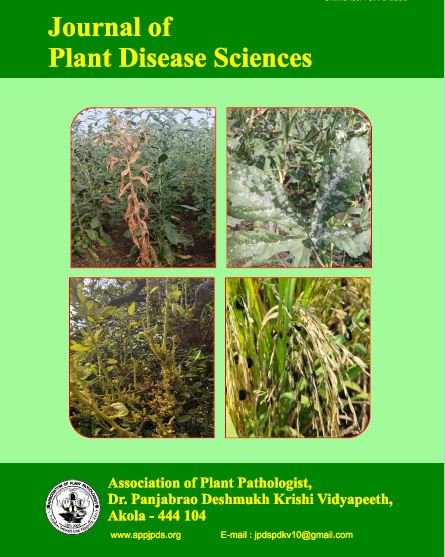BIOLOGICAL MANAGEMENT OF EARLY BLIGHT OF POTATO
DOI:
https://doi.org/10.48165/jpds.2024.19.02.02Keywords:
Alternaria alternata, Alternaria solani, Trichoderma viride, Pseudomonas fluorescensAbstract
Potato is one of the most well-known vegetables in India. The demand for potatoes is rising because they are nutritious and wholesome, rich in carbohydrates, and contain little fat. Early blight, caused by Alternaria solani and Alternaria alternata, is a widespread disease affecting potato crops globally. The incidence of early blight has been observed extensively in potato-growing areas of Kota district. Chemical control methods are commonly used for managing early blight, but limited work has been done on biological management. Among bio-agents, the results revealed that tuber treatment by spray method with Trichoderma viride @ 8 g/lit per 20 kg, combined with two foliar sprays @ 5 ml/lit of water, was effective against early blight and resulted in better potato yield. This was followed by Pseudomonas fluorescens @ 8 ml/lit per 20 kg of tuber, combined with two foliar sprays @ 5 ml/lit of water, which also showed significant disease control compared to the untreated control.References
Agrios, G. N. (2005). Plant Pathology (5th Ed.). Elsevier Academic Press, San Diego, CA, USA.
Camire, M. E., Kubow, S., & Donnelly, D. (2009). Potatoes and human health. Critical Reviews in Food Science and Nutrition, 49(10), 823-840.
Ellis, J. B., & Martin, G. (1882). E & M, 16, 1003.
Geremew, E. B., Steyn, J. M., & Annandale, J. G. (2007). Evaluation of growth performance and dry matter partitioning of four processing potato (Solanum tuberosum) cultivars. South African Journal of Plant and Soil, 35(3), 385-393.
Gupta, G., Parihar, R., Ahirwar, N. K., Snehi, S. K., & Singh, V. (2015). Plant growth promoting rhizobacteria (PGPR): Current and future prospects for development of sustainable agriculture. Microbiological Research, 7(2), 096-102.
Hussain, T., Singh, R., Kaushik, P., Lal, M., & Gupta, S. (2019). Duplex PCR for detection of early and late blight coinfecting potato. Indian Phytopathology, 76(2), 319-323.
Mane, M. M., Lal, M., Zghair, K. A., & Sobita, R. (2014). Efficacy of certain bioagents and fungicides against early blight of potato (Solanum tuberosum L.). Journal of Applied and Natural Science, 7, 433-436.
Mayee, C. D., & Datar, V. V. (1986). Phytopathometry. Tech. Bulletin, Marathwada Agricultural University, Parbhani, pp. 146.
Meena, P. K., Yadav, D. L., Meena, A. K., Patidar, C. B., & Singh, B. K. (2020). Efficacy of bio-agents and media against the early blight of potato. International Journal of Current Microbiology and Applied Sciences, 9(07), 2208-2213.
Murmu, S., Dey, P., & Chakraborty, B. (2015). Management of early blight of potato using biocontrol agents and plant extracts. Journal of Plant Protection Research, 7(2), 860-864.
Pandey, R. N., Jaisani, S., & Yadav, R. (2021). Trichoderma spp. in the management of stresses in plants and rural prosperity. Indian Phytopathology, 74, 453–467.
Reino, J. L., Guerrero, R. F., Hernandez-Galan, R., & Collado, I. G. (2008). Secondary metabolites from species of the biocontrol agent Trichoderma. Phytochemistry Reviews, 7(1), 89-123.
Saravanakumar, K., Yu, C., Dou, K., Wang, L., Li, Y., & Chen, X. (2016). Synergistic effect of Trichoderma-derived antifungal metabolites and cell wall degrading enzymes on enhanced biocontrol of Fusarium oxysporum f. sp. cucumerinum. Biological Control, 94, 37-46.
Troian, R. F., Steindorff, A. S., Ramada, M. H. S., Arruda, W. C., & Ulhoa, C. J. (2014). Mycoparasitism studies of Trichoderma harzianum against Sclerotinia sclerotiorum: Evaluation of antagonism and expression of cell wall-degrading enzyme genes. Biotechnology Letters, 36(10), 2095-2101.
Verma, A., Kumar, P., Harshita, R., & Jaiswal, S. (2018). Control agents and botanicals against early blight of tomato caused by Alternaria solani. The Pharma Innovation Journal, 7(3), 28-30.
Yadav, R., & Pathak, S. (2011). Management of early blight of potato through fungicides, botanicals, and bioagents. Plant Archives, 11, 1143-1145.
Zhang, D. Q., Mu, J., & Sun, H. (2016). Domestic and abroad research progress of potato tuber-specific storage protein patatin. Scientia Agricultura Sinica, 49(9), 1746-1756.

